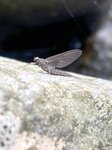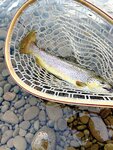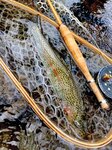Early May, one of the sweetest months of the year, especially in contrast to the drabness of late winter and early spring. There are already a number of colorful flowers blooming and blossoms pushing …
This item is available in full to subscribers.
Please log in to continue |




Early May, one of the sweetest months of the year, especially in contrast to the drabness of late winter and early spring. There are already a number of colorful flowers blooming and blossoms pushing out; the dark sturdy tree branches are now haloed with the unfurling of the softest green lace, and the return of the songbirds is heralded by cheerful morning and evening songs.
Area rivers and streams have been low over the past week, coinciding with the appearance of the leaves. During this time of year the trees are a tremendous draw on the water table and we will be depending on rainfall from now on to replenish our Catskill waters. On Sunday afternoon, May 5, the Beaverkill at Cooks Falls was flowing at 378 cubic feet per second, well below the median average flow of 616 cfs over 110 years of record-keeping. But with a forecast of a rainy week ahead we should see levels come up somewhat.
Last week was one of the best we can remember as far as angling success, with lots of large trout caught during the Hendrickson hatch. And although some sections of the river have slowed down a bit, anglers have done well in other streams. Quill Gordon hatches are winding down, but there are still some remaining Blue Quills and Hendricksons about.
“Catskill John” Bonasera had good fishing on his favorite small stream a week ago, and reported seeing a few Quill Gordons on the boulders alongside the stream. He fished a wet fly in size 12, and caught six rainbows, from 11 to 16 inches, along with two early releases - interestingly, not a single brown trout. He fished with his Canazon rod, and three of the fish took “on the swing, the other three dead drifted.”
These early-season mayflies can be distinguished by their color and size. The Quill Gordons are the first major hatch that occurs once water temperatures have warmed to about 50 degrees Fahrenheit. They are a dark colored mayfly with slate-colored wings and two tails, in about size#14-#12.
Next to hatch are the Blue Quills: these are also dark-colored mayflies, with a blue wing and brownish body, but are smaller, usually a size #18-#16 and sport three tails. The Hendricksons will follow these, although there is a good overlap among all three flies, such as we have seen the past week.
Hendricksons are larger than Blue Quills, usually size #14 -#12, and also have three tails - but they are lighter in color than the Blue Quills, having a brown body with lighter colored legs and wings of brown. As the season progresses toward summer, the mayflies tend to get lighter in color.
We are now seeing lots of caddis flies around - and it’s about time for the Shad fly to hatch. This dark-colored caddis hatches at about the same as the Shad run up the Delaware River to spawn (and the Shad bush, or Serviceberry, blooms - thus the nickname). This hatch is one of the most prolific, so much so that when driving along the river or even a wet road nearby during the hatch, your car will be plastered with the dark flies that sport a green egg sac.
Dan Park, of Livingston Manor, has enjoyed good fishing this past week. While on the Beaverkill he caught a nice brown trout on a Quill Gordon. He noticed a number of caddisflies and Blue Winged Olives hatching, and tied on a caddis imitation that was a brightly colored attractor fly - and managed to entice a beautiful rainbow trout. Dan said no one else was fishing, and it was very peaceful and nice to be out! He returned this past Sunday and fished for a bit in the rain; he used nymphs as there were not many flies hatching or on the surface, and was rewarded with four fish as of this writing, both rainbow and brown trout.
Nymphing is more demanding of the angler and more challenging than fishing with dry flies but is also more rewarding, as this method of fishing can be very productive during the early part of the fishing season and any time the water is high or discolored, such as during a rainstorm.
Comments
No comments on this item Please log in to comment by clicking here